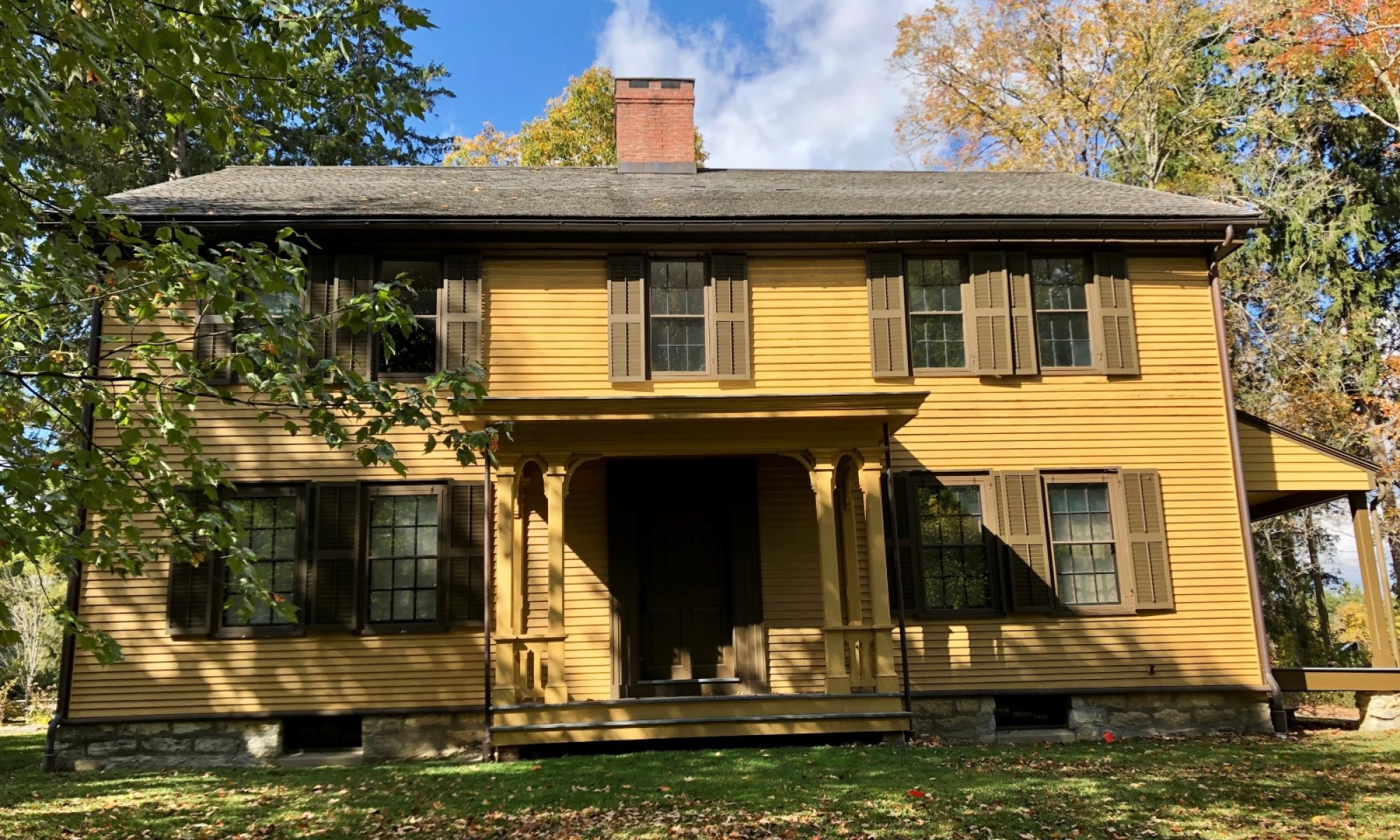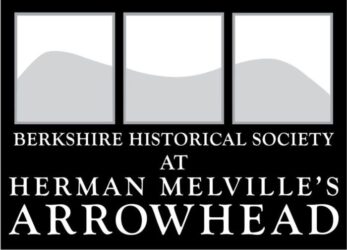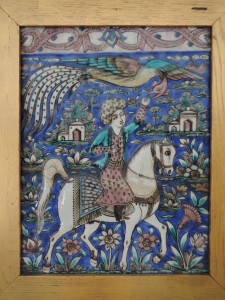Herman Melville’s Persian Tile. Framed ceramic tile, commemorating the victory of Islam in Constantinople/Istanbul. It shows a sultan or prince riding a horse with the mythical bird Huma (also Homa) flying above him. Tile measures approximately 10″ x 14″. Tile donated by Herman Melville’s great-grandson. On display in Melville’s Study at Arrowhead.
Melville purchased this tile on a trip through Europe and the Mediterranean in 1856-57. The bird Huma is said to never land on the ground, living its entire life in flight. Melville may be referencing this bird in when he writes of “the bird that never alights” in the chapter entitled “The Tail” in Moby-Dick. The 1856-57 trip inspired Melville’s epic poem Clarel, set in the Middle East. Accession number 1999.04
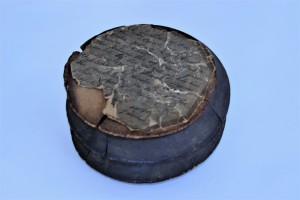 Section of a Cider Press. A label glued to the top of the press reads: “A Section of One of the Screws in the Cider Mill of Capt. Daniel Brown of Cheshire, Massachusetts that pressed the big cheese presented by the citizens of Cheshire January 1802 to Thomas Jefferson President of the United States. The presentation made by the Rev. John Leland Pastor of the Baptist Church weight of cheese 1450 dia. 4 ft. 7 inches”
Section of a Cider Press. A label glued to the top of the press reads: “A Section of One of the Screws in the Cider Mill of Capt. Daniel Brown of Cheshire, Massachusetts that pressed the big cheese presented by the citizens of Cheshire January 1802 to Thomas Jefferson President of the United States. The presentation made by the Rev. John Leland Pastor of the Baptist Church weight of cheese 1450 dia. 4 ft. 7 inches”
This cider press was used to make the “Mammoth Cheese” that the people of Cheshire, MA, presented to Thomas Jefferson in 1802. The cheese was intended to celebrate Jefferson’s presidential victory as a Republican over Federalist John Adams as well as Jefferson’s defense of religious freedom. The cheese represented the output of Cheshire dairy farms for one day and was made “by the personal labour of free-born farmers (without a single slave to assist)”¹. Accession number 1967.195.01
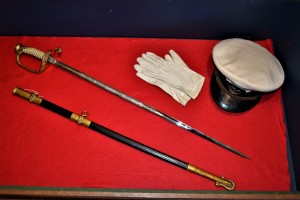 WWII Naval Officer’s Sword, Hat, and Gloves owned by Lieutenant Commander James A. McCulloch. Lt. Cdr. McCulloch received this sword in 1941. The inscription on the sword reads “Lt. Cdr. James A. McCulloch 69970 USNR.” Exhibited as part of I Will Never Forget… Berkshire County in WWII exhibit during the 2018 season.
WWII Naval Officer’s Sword, Hat, and Gloves owned by Lieutenant Commander James A. McCulloch. Lt. Cdr. McCulloch received this sword in 1941. The inscription on the sword reads “Lt. Cdr. James A. McCulloch 69970 USNR.” Exhibited as part of I Will Never Forget… Berkshire County in WWII exhibit during the 2018 season.
Naval officers have used swords since the time of the Continental Navy. The pattern of this sword dates from 1854, though subsequent designs became slimmer and straighter. Initially the swords were used as weapons, though they are now reserved for use when full dress is required for ceremonies. In 1942, a year after Lt. Cdr. McCulloch received his, wear of officer’s swords was suspended in order to save resources for the war effort. Wear of the sword was reinstated in 1954 and has been worn since. Accession number 1992.145.01a-c
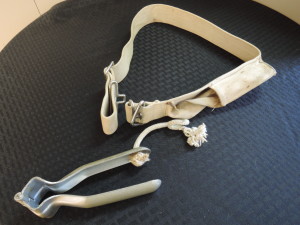 C.J. Bousquet Ski Tow Rope Gripper. A canvas belt attached to a “gripper,” invented by Clarence Bousquet, helped pull people up the mountain at his ski area in Pittsfield, MA. Patent US2230024A filed June 3, 1939, approved Jan. 28, 1940.
C.J. Bousquet Ski Tow Rope Gripper. A canvas belt attached to a “gripper,” invented by Clarence Bousquet, helped pull people up the mountain at his ski area in Pittsfield, MA. Patent US2230024A filed June 3, 1939, approved Jan. 28, 1940.
Clarence Bousquet operated a ski area on his property beginning in the 1930s. He installed a number of tow ropes which skiers held onto and were pulled up the mountain. As more trails opened, Bousquet became a premier ski resort. The Tow Rope Gripper that Bousquet invented relieved strain on hands, wrists, and arms and was immensely popular. Over 500,000 were sold and several people designed grippers based off of his patent. Accession number 2016.04
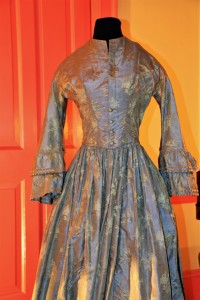 Louise Crane’s Wedding Dress, blue-grey satin with embroidered flower details. Brocaded blue-grey taffeta with front buttoned bodice and pagoda sleeves. This dress was worn over a hoop. Worn by Louise Laflin of Lee, MA when she married Zenas M. Crane, of the Crane Paper Co., on April 2, 1850.
Louise Crane’s Wedding Dress, blue-grey satin with embroidered flower details. Brocaded blue-grey taffeta with front buttoned bodice and pagoda sleeves. This dress was worn over a hoop. Worn by Louise Laflin of Lee, MA when she married Zenas M. Crane, of the Crane Paper Co., on April 2, 1850.
The tradition of white wedding dresses didn’t emerge until after the mid 1800s when Queen Victoria wore a white dress with Honiton lace at her highly publicized marriage to Prince Albert of Saxe-Coburg. Until the white wedding dress became common, women wore the best dress they owned or could afford. Accession number 1967.426
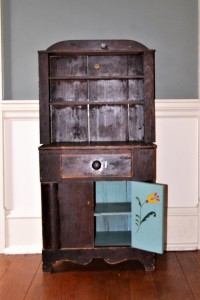 Toy Cupboard that belonged to Herman Melville’s youngest daughter, Frances Melville. Cupboard stands 3 feet tall, is stained dark brown outside, and painted robin’s egg blue with flowers on the inside. The cupboard is from c. 1860. This piece was donated by Herman Melville’s great-granddaughter. On display in the South Parlor at Arrowhead.
Toy Cupboard that belonged to Herman Melville’s youngest daughter, Frances Melville. Cupboard stands 3 feet tall, is stained dark brown outside, and painted robin’s egg blue with flowers on the inside. The cupboard is from c. 1860. This piece was donated by Herman Melville’s great-granddaughter. On display in the South Parlor at Arrowhead.
Frances “Fannie” Melville was born in 1855, while the Melville’s were living at Arrowhead. She passed on the collection of Herman Melville’s letters and manuscripts (collected in a breadbox) to her daughter Eleanor Thomas Metcalf, who helped publish the unfinished manuscript of Billy Budd in 1924, which renewed interest in Melville’s writing. Accession number 1978.127
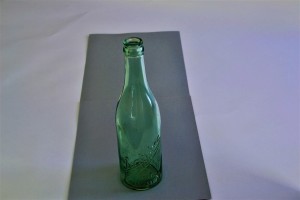 Berkshire Brewing Association Bottle, c. 1910. This bottle was made by Owens Automatic Bottle Making Machine, discernible by a circle on the bottom of the base. One of the many antique bottles the BCHS holds in its collection.
Berkshire Brewing Association Bottle, c. 1910. This bottle was made by Owens Automatic Bottle Making Machine, discernible by a circle on the bottom of the base. One of the many antique bottles the BCHS holds in its collection.
Under various ownership and names, the Berkshire Brewing Association operated from 1867 until prohibition forced its closure in 1918. In addition to beer, such as “Greylock Ale,” Berkshire Brewing Association brewed a tonic called “Berkshire Malt Extract.” The extract was made with barley and hops and aged for 12 months. It was sold in pharmacies and recommended for nursing mothers “to produce even temperaments in the children.” Accession number 1970.45.
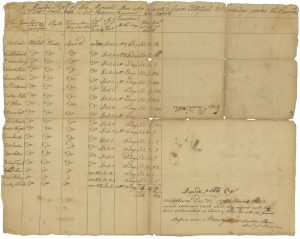 “A Muster Roll of the Minute Men who marched from Pittsfield to Cambridge under the Command of Capt. David Noble in Colo. Paterson’s Regiment and Returned” This muster roll is a travel, service, and pay record of 18 Minute Men who responded to the Lexington/Concord Alarm, did not at that time enlist in the Colony army being formed at headquarters in Cambridge and therefore returned home by order. They were all from Pittsfield and ranked as privates in the minute company of Captain David Noble. Many, including Dr. Childs, aged 27, whose name appears last in the first column, enlisted a few weeks later. The eight columns register their names, town, rank, marching date, round-trip mileage, travel pay, service time, and sum total of travel and service pay. This small document opens the door to a stirring time in American history.
“A Muster Roll of the Minute Men who marched from Pittsfield to Cambridge under the Command of Capt. David Noble in Colo. Paterson’s Regiment and Returned” This muster roll is a travel, service, and pay record of 18 Minute Men who responded to the Lexington/Concord Alarm, did not at that time enlist in the Colony army being formed at headquarters in Cambridge and therefore returned home by order. They were all from Pittsfield and ranked as privates in the minute company of Captain David Noble. Many, including Dr. Childs, aged 27, whose name appears last in the first column, enlisted a few weeks later. The eight columns register their names, town, rank, marching date, round-trip mileage, travel pay, service time, and sum total of travel and service pay. This small document opens the door to a stirring time in American history.
Read more about it HERE.
